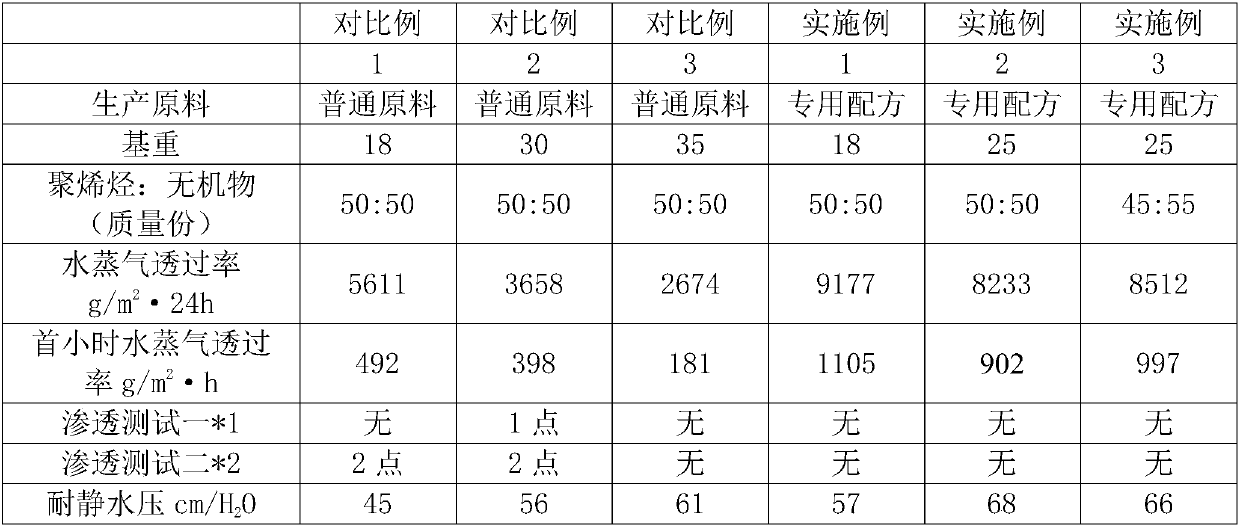A kind of high moisture permeability polyolefin microporous breathable film
A polyolefin, breathable film technology, applied in other household appliances, flat products, household appliances, etc., can solve the problems of weakened humidity regulation, film leakage, and inability to effectively improve the experience of sanitary products.
- Summary
- Abstract
- Description
- Claims
- Application Information
AI Technical Summary
Problems solved by technology
Method used
Image
Examples
Embodiment 1
[0031] The polyolefin microporous air-permeable membrane of this example is prepared using special formula raw materials, specifically including the following steps:
[0032] A. Polyolefin substrate and inorganic filler are blended, extruded and granulated at a mass ratio of 1:1 to obtain a composite material and granulated. The polyolefin substrate is a mixture of metallocene polyethylene and linear low-density polyethylene with a mass ratio of 3:2. Among them, metallocene polyethylene uses a melt index of 3.5g / 10min and a density of 0.927. Linear low density polyethylene uses a melt index of 2.3g / 10min and a density of 0.917. The inorganic filler is: inorganic particles with a particle diameter of 3-5 μm and a particle size distribution of more than 80%. The inorganic filler is a mixture of calcium carbonate and titanium dioxide with a mass ratio of 50:1.
[0033] B. The composite material particles are extruded and melted by a casting extruder, and the melt temperature i...
Embodiment 2
[0038] The raw materials and preparation method used in the polyolefin microporous air-permeable membrane involved in this example are the same as those in Example 1, except that:
[0039] The basis weight of the obtained product is 25gsm;
[0040] Relevant performance tests were carried out on the prepared microporous air-permeable membrane with a basis weight of 25 gsm, and the results are shown in Table 1.
Embodiment 3
[0042] The preparation method of the polyolefin microporous air-permeable membrane involved in this embodiment is the same as that of Example 1, the difference is that:
[0043] (1) In step A: the polyolefin substrate and the inorganic filler are blended and extruded at a mass ratio of 9:11 to obtain a composite material and granulated. The polyolefin substrate is a mixture of metallocene polyethylene and linear low-density polyethylene with a mass ratio of 4:1. Among them, metallocene polyethylene uses a melt index of 3.5g / 10min and a density of 0.927. Linear low density polyethylene uses a melt index of 2.3g / 10min and a density of 0.917. The inorganic filler is: inorganic particles with a particle diameter of 3-5 μm and a particle size distribution of more than 80%. The inorganic filler is a mixture of calcium carbonate and titanium dioxide with a mass ratio of 50:1.
[0044] (2) The basis weight of the prepared product is 25gsm;
[0045] Relevant performance tests were ...
PUM
| Property | Measurement | Unit |
|---|---|---|
| melt flow index | aaaaa | aaaaa |
| density | aaaaa | aaaaa |
| density | aaaaa | aaaaa |
Abstract
Description
Claims
Application Information
 Login to View More
Login to View More - R&D
- Intellectual Property
- Life Sciences
- Materials
- Tech Scout
- Unparalleled Data Quality
- Higher Quality Content
- 60% Fewer Hallucinations
Browse by: Latest US Patents, China's latest patents, Technical Efficacy Thesaurus, Application Domain, Technology Topic, Popular Technical Reports.
© 2025 PatSnap. All rights reserved.Legal|Privacy policy|Modern Slavery Act Transparency Statement|Sitemap|About US| Contact US: help@patsnap.com

